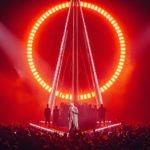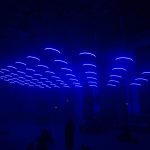How does a production designer light and stage the most human form of a natural phenomenon?
“They are like little mini tornados on stage,” laughs Production Designer Alex Skowron. “They just spin all over.”
“They” are Fall Out Boy (FOB), the hot young band that just finished its successful Infinity on High tour. It’s led by sarcastically slanted bass-ist/songwriter and potential tabloid-fodder Pete Wentz. (Between his club fights and rotation of high-profile girlfriends, he’s precariously close to becoming this country’s answer to Pete Doherty). Wentz, a talented showman with a whacked imagination, pushed to create a show that would become a visual orgy of the senses, filled with moving video screens, pyrotechnics and pranks. Keeping up with the band and supporting their energetic show takes some of the most creative minds in the business.
Crew chief, Upstaging’s Chris Stinebrink, was handed the duties of keeping it all together on the road. According to Stinebrink, all the pieces of the show went together seamlessly, and he complimented the design team who, he says, put together something that goes up and down quickly and easily. But the ambitious show ended up being too big for some of the venues the band played; at every tour site, they needed to immediately assess how much of the original show could be used.
“Scaling the show back in certain places was the biggest challenge we’ve had in the tour,” Stinebrink adds. “We had to shift, change or drop small elements of the pyro, video, or sets. Sometimes we lost a little bit of stuff here and there.” The trim height in the various venues was particularly sticky and would change what he considers the pinnacle of the show, the big truss that lights up “FOB” In some situations, the audiences only got a big “O” (not that kind though).

A Creative Brain Trust
Skowron had worked with FOB last year, assisting them with the scenic and lighting design. This year, they turned to him and asked for a proposal for this tour.
“It was last-minute for me to get into the picture — I was like the last of three designers presenting something,” he explains. “So I had to get something together quick. I was on the road so I had to use all the resources I had.” One of his resources turned out to be freelance lighting designer Nook Shoenfeld.
“Nook took ideas for a truss configuration, tracking video wall and some really basic scenic elements and put it in ESP,” Skowron says. “Then we passed folders and e-mails back and forth until I got an initial rough package to put together. Chris Tousey, who is really good at graphics, added some things quickly that were awesome.” Skowron turned it all into an iMovie and presented it to production manager David Norman and the band.
“iMovie is great — that’s how I present all my ideas to bands these days. No one wants to look at static drawings. So you do a movie, put their latest single behind it, and then the next thing that happens is they’re calling you and saying, ‘Let’s do it.’ ”
One of Skowron’s first ideas was to use a tracking trolley wall. For these moving video walls, they turned to SGPS of Las Vegas. “The trolley system was 80 feet long, and it was held up with nine two-ton motors. A Navigator computer control system ran it all. That enabled the walls to not only go up-and-down, but left-to-right over a 70-foot span of truss.” The walls were Nocturne V-9 LED, sized 34 feet by 16 feet.
The show started with the walls spread apart at different heights. Over the course of the opening two-minute video intro, they moved and tracked together until they formed one solid wall. Throughout the night, they would split up into different configurations for different songs.
“In putting it together, Alex and I did all the cueing of the show at his house on a portable ESP system from Upstaging,” Schoenfeld says. “Then we had a week in rehearsals to change all the colors to match the video content as best we could. The design was pretty simple once Alex decided what to do with the video elements. We didn’t want to compete with video, so instead we chose our lighting positions to move the fixtures to wherever there weren’t any video elements. Alex chose a big package of side lighting with the trusses hanging down in tiers, one under the other. When it’s all turned on, it makes a pretty big statement and is not washed out by the giant TV behind it.”
The two side trusses were tiered and filled with Martin MAC 700s, Robe moving lights, and Martin Atomic 3K strobes. The biggest take-away lighting-wise was the truss configuration, including those three 20’ wide by 30’ tall letters that spelled out “FOB.” “There are 180 Color Kinetics Color Blast LED fixtures mounted in these trusses,” says Schoenfeld. At first the audience doesn’t see them, then later in the show, moving motors tilt the trusses toward the audience for a crowd-screaming effect. “But they primarily wash the whole stage when not spelling out the band’s name.”
John Beswick of Nocturn put the videos together with the band’s full confidence. “A few phone conversations and they let me go,” he says. “They trusted me. I respect that. Video directors don’t get that very often.”
The video content he compiled was often startling. “Their lyrics are pretty profound,” Beswick says. “But Pete didn’t want the video to dictate what the song was about, but use images in such a way that it allows the audience to decide for themselves what the song is about.” He adds that Wentz wanted Andy-Warhol-meets-Jim-Jones — bright colors and poignant imagery that made a statement. Old Soviet-style artwork was created by a Russian artist, and some Terry Gilliam-like images were thrown into the mix as well.
“The biggest challenge was that it’s really a big show that went into a lot of medium and smaller venues, which made it tough to put on the show the band wanted people to see,” Skowron says. “The show as it is really lends itself to an arena and loses a little bit when it’s outside because you don’t have that controlled environment.”
Explosions & Gags Galore
Wentz had some gags and elements in mind for the show, including a “toaster” in the opening that the band pops out of onto the stage. Also, Wentz was particularly inspired by some restrooms he’d seen in some swanky restaurant — the kind where the stalls appear to be clear glass, but when a human in need enters and assumes the position, the glass “fogs up” to ensure the desired privacy. He wanted to use this idea in his show and had two such stalls flanking the stage (which the creative team took to calling “quick-change rooms”).
The gag is that the boys go into them midway through to change outfits, and as they undress, the glass “fogs,” thus leaving the multitude of 13-year-old girls who are the band’s core audience to fill in the missing pieces with their collective imaginations. A bigger gag happens at the end of the show during the encore: Wentz and guitarist Joe Trohman go in and are silhouetted and appear to be playing from there — but, in fact, it’s roadies pretending to be the two musicians, who then show up in the audience on a 4-foot by 8-foot riser in the seats.
The band wanted drummer Andrew Hurley up unusually high —10 feet — on risers. Skowron also put him on a track that moved him from 24 feet to 16 feet upstage and then built ramps to it, which the other band members can run up. For the encores, the drummer got a little closer: a separate drum set was hidden under the stage thrust. It worked like an old cabinet sewing machine — it was mounted upside down on top of the riser, then flipped right side up, with Hurley drumming away for a neat effect. Skowron says the flipping riser was originally a gag left over from a satellite stage idea that ended up not being used.
For special effects, Norman turned to Lorenzo Cornacchia and Pyrotek Special Effects, who had the challenge of making it all go “boom!”
“We used a number of fireballs, dragons and gerb chases that are designed to be cued in sync with specific riffs or accents of the music,” Cornacchia says. “The opening effects are coordinated with a video introduction of the band member’s heads being shot off by a pellet gun one at a time. Following the intro, a 24-chase silver gerb begins from offstage right and left to onstage center and explodes into a finale cue of red flame and hot bursts. Later there’s a concussion during the [Michael Jackson cover] song “Thriller.”
Streamer mines pour into the audience and are cued by another concussion effect during the song “Sugar.” This performance also includes a flame dragon chase bursting to heights of 25 feet during the course of the show. As the show concludes, a final waterfall effect occurs from the upstage truss. The waterfall effect creates a 40-foot wide downward spiral of silver sparks filling the entire upstage edge. Through the duration of the waterfall, metallic confetti is cued in from four downstage turbo confetti blowers, filling the entire stage and venue.
Cornacchia worked with show director Andrew Logan and ran things by Skowron to work out any conflicts so the video, lighting and effects would all work together. Rob Liscio (main shooter) and Jan Sanderse (gas specialist) went on the road with the band to carry out the show and make the necessary adjustments, depending on the venue.
None of it out-staged the band, whose personality and sense of humor was always prevalent. For example, in a decidedly low-tech moment, the band takes a break and lets their friend, who goes by the not terribly flattering non-de-plume “dirty guy,” come on stage, stand in front of a pitching machine and take softballs to the chest for five minutes.
Kids today…
Gear List
217 Color Kinetics Color Blast LED fixtures
1 FOB truss
37 Martin Atomic strobes
8 Martin Big Lights
17 Martin MAC 2000 profiles
17 Martin MAC 2000 washlights
22 Martin MAC 700 washlights
2 Martin Maxxyz consoles
4 8-lite Mole Fays
1 Motion control
15 4’ MR16 Strip
4 Reel EFX DF-50 haze machines
15 Robe 1200 spots
6 Roy lite
12 Station I-Com
12 Large-format XL Color Faders
6 X Lite
38 1-ton motors
6 1/2-ton motors
6 30” D-type truss
3 Double “T” truss
27 10’ truss/black
4 Truss spot
4 UnderHung spot basket


